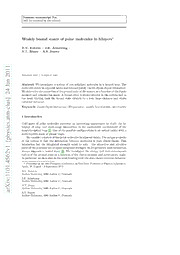
Weakly bound states of polar molecules in bilayers PDF
Preview Weakly bound states of polar molecules in bilayers
Noname manuscript No. (will be inserted by theeditor) Weakly bound states of polar molecules in bilayers⋆ D.V. Fedorov · J.R. Armstrong · N.T. Zinner · A.S. Jensen 1 1 0 2 Received: date/Accepted: date n a Abstract We investigate a system of two polarized molecules in a layered trap. The J moleculesresideinadjacentlayersandinteractpurelyviathedipole-dipoleinteraction. 4 Wedeterminethepropertiesofthegroundstateofthesystemasafunctionofthedipole 2 moment and polarization angle. A boundstate is always present in thesystem and in ] the weak binding limit the bound state extends to a very large distance and shows s universal behavior. u cl Keywords dipole-dipoleinteraction·2Dgeometry·weaklyboundstates·universality - m t 1 Introduction a . s Cold gases of polar molecules represent an interesting opportunity to study the in- c terplay of long- and short-range interactions in the controllable environment of the i s magneto-opticaltrap[1].Oneofthepossibleconfigurationsisanopticallatticewitha y multi-layered stack of planar traps. h p Weconsiderasystemoftwopolarmoleculesinadjacentlayers.Theuniqueproperty [ of the system is that the interaction between molecules is pure dipole-dipole. This interaction has the integrated strength equal to zero – the attractive and repulsive 1 partsofthepotentialareofequalintegratedstrength.In2D-geometrysuchinteraction v always supports a bound state [3]. We investigate the energy and root-mean-square 2 6 radius of theground state as a function of the dipole moment and polarization angle. 5 Inparticularweshowthatintheweakbindinglimitthestateshowsuniversalbehavior. 4 . ⋆ Presentedatthe21stEuropeanConferenceonFew-BodyProblemsinPhysics,Salamanca, 1 Spain,30August-3September 2010 0 1 D.V.Fedorov 1 AarhusUniversity,8000AarhusC,Denmark : J.R.Armstrong v AarhusUniversity,8000AarhusC,Denmark i X N.T.Zinner r AarhusUniversity,8000AarhusC,Denmark a A.S.Jensen AarhusUniversity,8000AarhusC,Denmark 2 0.6 D2>0 0.4 D2<0 2 0.2 b / 2 D 0 , W r -0.2 -0.4 -0.6 0 1 2 3 4 5 r,b Fig. 1 The dipole-dipole potential (2) in the rotationally symmetric case, θ = π/2, as a functionofr= x2+y2.Thepotential ismultipliedbyr forbettervisibility. p 2 The Schr¨odinger equation for two dipoles in bilayer geometry ThesystemoftwopolarmoleculesinabilayergeometryisdescribedbytheSchr¨odinger equation, 2 2 2 ¯h ∂ ∂ − + +W(x,y) ψ(x,y)=Eψ(x,y), (1) (cid:20) 2µ(cid:18)∂x2 ∂y2(cid:19) (cid:21) whereµisthereducedmassofthetwomolecules,xandy aretherelativecoordinates in thelayer plane, and W is thedipole-dipole potential, 2 2 2 2 x +y +b −3(xcosθ+bsinθ) W(x,y)=D2 (x2+y2+b2)5/2 , (2) where b is the distance between the layers, θ is the polarization angle measured from the layer, and D2 is the product of the dipole moments of the molecules taken with thepositiveornegativesignifthedipolesarecorrespondinglyparalleloranti-parallel. The dipole-dipole potential has the integrated strength identically equal to zero – ithasattractiveandrepulsivepartswithequalintegratedstrength,seefigure1.Sucha potential is expectedto always haveabound state in atwo-dimensional geometry [3]. 3 Ground state energy Wehavecalculatednumericallythebindingenergyofthegroundstateofthesystemof two polarized molecules for different dipole moments as a function of the polarization angle for parallel and anti-parallel orientation of thedipoles. Theresults areshown in figure 2. Forparallel dipolesthestrongest bindingisachievedwhenthedipoles areperpen- dicular to the layer, θ = π/2. The binding decreases monotonically with increasing polarization angle. Approaching θ=0, thebinding decreases significantly but still re- mainsfinite.Foranti-paralleldipolesthesituationisopposite–thebindingisstrongest forθ=0anddecreasestowardsθ=π/2.Inbothcasesastrongerdipolemomentleads to stronger binding. 3 0 -5 ) 2 b µ 2 ( -10 / 2 ¯h E, D2=−7 -15 D2=−9 D2=+7 D2=+9 -20 0 π/4 π/2 θ Fig.2 GroundstateenergyofthesystemoftwopolarmoleculesdescribedbytheSchro¨dinger equation (1) as a function of the polarization angle θ for parallel, D2 >0, and anti-parallel, D2<0,orientationofthedipoles.D2 isinunitsofh¯2b/(2µ). 4 Root-mean-square radius and universality in the weak binding limit Forshort-rangepotentialsintwodimensionstherelationbetweentheroot-mean-square radius,Rrms,andthebindingenergy,|E|,isuniversalinthelimitofweak binding[4], 2 2 E→0 2 ¯h Rrms −→ . (3) 32µ|E| −3 The dipole-dipole potential asymptotically decreases as r , that is faster than −2 the centrifugal barrier, r . It is thus of a short-range type and must obey the uni- versal relation. Indeed the numerical calculations show that the universal regime is approachedat|E|∼0.001 h¯2 ,seefigure3.Fortheparallel(anti-parallel)orientation 2µb2 1.2 D2>0 D2<0 1 2/3 2¯hµE|| /2 0.8 ms 2Rr 0.6 0.4 0.0001 0.001 0.01 0.1 1 |E|, 2hµ¯2b2 Fig. 3 Root-mean-squareradiusRrms ofthesystemoftwopolarmoleculesdescribedbythe Schro¨dinger equation (1) as a function of the binding energy |E| for parallel, D2 > 0, and anti-parallel, D2 <0, orientation of the dipoles. The binding energy was varied by changing the dipole-dipole strength D2 while the polarization angle was fixed at θ = π/2. The model independent (universal)asymptoticvalueforvanishingbindingis2/3. 4 ofthedipolestheuniversallimitisreachedfrombelow(above)reflectingthegeometry ofthedipole-dipole potentialforthetwoconfigurations–eitherabarrieroracore,as illustrated in figure 1. 5 Conclusion We have investigated the ground state of a system of two polar molecules in a bi- layer geometry. The ground state is always bound with the binding energy strongly dependentonthepolarization angle.Intheweakbindinglimitthesystemexhibitsthe universal relation between the root-mean-squareradius and thebindingenergy. References 1. A. Micheli, G. Pupillo, H P. Bu¨chler, and P. Zoller, Cold polar molecules in 2D traps: Tailoringinteractionswithexternalfieldsfornovelquantumphases,Phys.Rev.A76043604 (2007) 2. J.R.Armstrong,N.T.Zinner,D.V.Fedorov,andA.S.Jensen,BoundStatesandUniversality inLayersofColdPolarMolecules,EurophysicsLetters9116001(2010) 3. B. Simon, The Bound State of Weakly Coupled Schro¨dinger Operators in One and Two Dimensions,AnnalsofPhysics97279-288(1976) 4. E.Nielsen,D.V.Fedorov,A.S.Jensen,andE.Garrido,Thetree-bodyproblemwithshort- rangeinteractions, PhysicsReports347373–459(2001)
